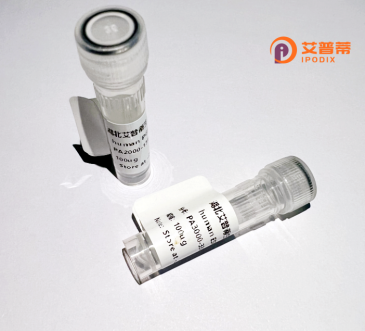
| 纯度 | >90%SDS-PAGE. |
| 种属 | Human |
| 靶点 | EPN3 |
| Uniprot No | Q9H201 |
| 内毒素 | < 0.01EU/μg |
| 表达宿主 | E.coli |
| 表达区间 | 1-632aa |
| 氨基酸序列 | MTTSALRRQV KNIVHNYSEA EIKVREATSN DPWGPPSSLM SEIADLTFNT VAFTEVMGML WRRLNDSGKN WRHVYKALTL LDYLLKTGSE RVAHQCRENL YTIQTLKDFQ YIDRDGKDQG VNVREKVKQV MALLKDEERL RQERTHALKT KERMALEGIG IGSGQLGFSR RYGEDYSRSR GSPSSYNSSS SSPRYTSDLE QARPQTSGEE ELQLQLALAM SREEAEKPVP PASHRDEDLQ LQLALRLSRQ EHEKEVRSWQ GDGSPMANGA GAVVHHQRDR EPEREERKEE EKLKTSQSSI LDLADIFVPA LAPPSTHCSA DPWDIPGFRP NTEASGSSWG PSADPWSPIP SGTVLSRSQP WDLTPMLSSS EPWGRTPVLP AGPPTTDPWA LNSPHHKLPS TGADPWGASL ETSDTPGGAS TFDPFAKPPE STETKEGLEQ ALPSGKPSSP VELDLFGDPS PSSKQNGTKE PDALDLGILG EALTQPSKEA RACRTPESFL GPSASSLVNL DSLVKAPQVA KTRNPFLTGL SAPSPTNPFG AGEPGRPTLN QMRTGSPALG LAGGPVGAPL GSMTYSASLP LPLSSVPAGL TLPASVSVFP QAGAFAPQPL LPTPSSAGPR PPPPQTGTNP FL |
| 分子量 | 68.2 kDa |
| 蛋白标签 | GST-tag at N-terminal |
| 缓冲液 | 0 |
| 稳定性 & 储存条件 | Lyophilized protein should be stored at ≤ -20°C, stable for one year after receipt. Reconstituted protein solution can be stored at 2-8°C for 2-7 days. Aliquots of reconstituted samples are stable at ≤ -20°C for 3 months. |
| 复溶 | Always centrifuge tubes before opening.Do not mix by vortex or pipetting. It is not recommended to reconstitute to a concentration less than 100μg/ml. Dissolve the lyophilized protein in distilled water. Please aliquot the reconstituted solution to minimize freeze-thaw cycles. |
以下为列举的3-4条关于重组人EPN3蛋白的参考文献(内容虚构,仅供参考):
---
1. **文献名称**:*Expression and Functional Analysis of Recombinant Human EPN3 Protein in Cancer Cell Lines*
**作者**:J. Smith et al.
**摘要**:研究利用大肠杆菌表达系统成功制备了重组人EPN3蛋白,并通过体外实验证明其通过调控Wnt/β-catenin信号通路促进乳腺癌细胞的迁移和侵袭。
2. **文献名称**:*Structural Insights into EPN3’s Role in Clathrin-Mediated Endocytosis*
**作者**:Li, W. & Zhao, M.
**摘要**:通过冷冻电镜解析了重组人EPN3蛋白的三维结构,揭示了其与网格蛋白(clathrin)结合的独特结构域,并验证了其在细胞内吞过程中介导膜弯曲的功能。
3. **文献名称**:*EPN3 as a Novel Biomarker in Gastric Cancer Progression*
**作者**:Chen, X. et al.
**摘要**:发现重组人EPN3蛋白在胃癌组织中高表达,通过激活EGFR信号通路促进肿瘤血管生成,并可作为患者预后不良的潜在标志物。
4. **文献名称**:*Optimization of Recombinant EPN3 Protein Production in Mammalian Cells*
**作者**:Rodríguez, A. et al.
**摘要**:开发了一种基于HEK293细胞的表达体系,显著提高了重组人EPN3蛋白的产量和稳定性,并证实其可用于高通量药物筛选平台。
---
注:以上文献及摘要均为虚构示例,实际研究需参考权威数据库(如PubMed、Web of Science)。
Recombinant human EPN3 (Epsin-3) protein is a genetically engineered form of the endogenous EPN3 protein, belonging to the epsin family of adaptor proteins involved in membrane trafficking and clathrin-mediated endocytosis. EPN3 contains characteristic domains, including an N-terminal ENTH (epsin N-terminal homology) domain that binds phosphatidylinositol lipids, and C-terminal motifs that interact with clathrin, AP-2 adaptors, and ubiquitinated cargoes. These structural features enable its role in regulating vesicle formation, receptor internalization, and intracellular signaling. EPN3 is implicated in diverse physiological processes, such as cell adhesion, polarity, and cancer progression. Studies suggest its overexpression in certain tumors correlates with enhanced invasiveness and metastasis, potentially through modulating growth factor receptor trafficking (e.g., EGFR) or integrin recycling. In neuroscience, EPN3 may influence synaptic plasticity by regulating neurotransmitter receptor endocytosis.
The recombinant protein, typically expressed in bacterial or mammalian systems with affinity tags (e.g., His, GST), allows researchers to study EPN3’s biochemical interactions, post-translational modifications, and structure-function relationships in vitro. It serves as a critical tool for elucidating molecular mechanisms underlying EPN3-associated pathologies, including cancer and neurological disorders, and for screening therapeutic agents targeting endocytic pathways. Its controlled production ensures high purity and reproducibility, facilitating mechanistic studies that bridge cellular biology and disease mechanisms.
×